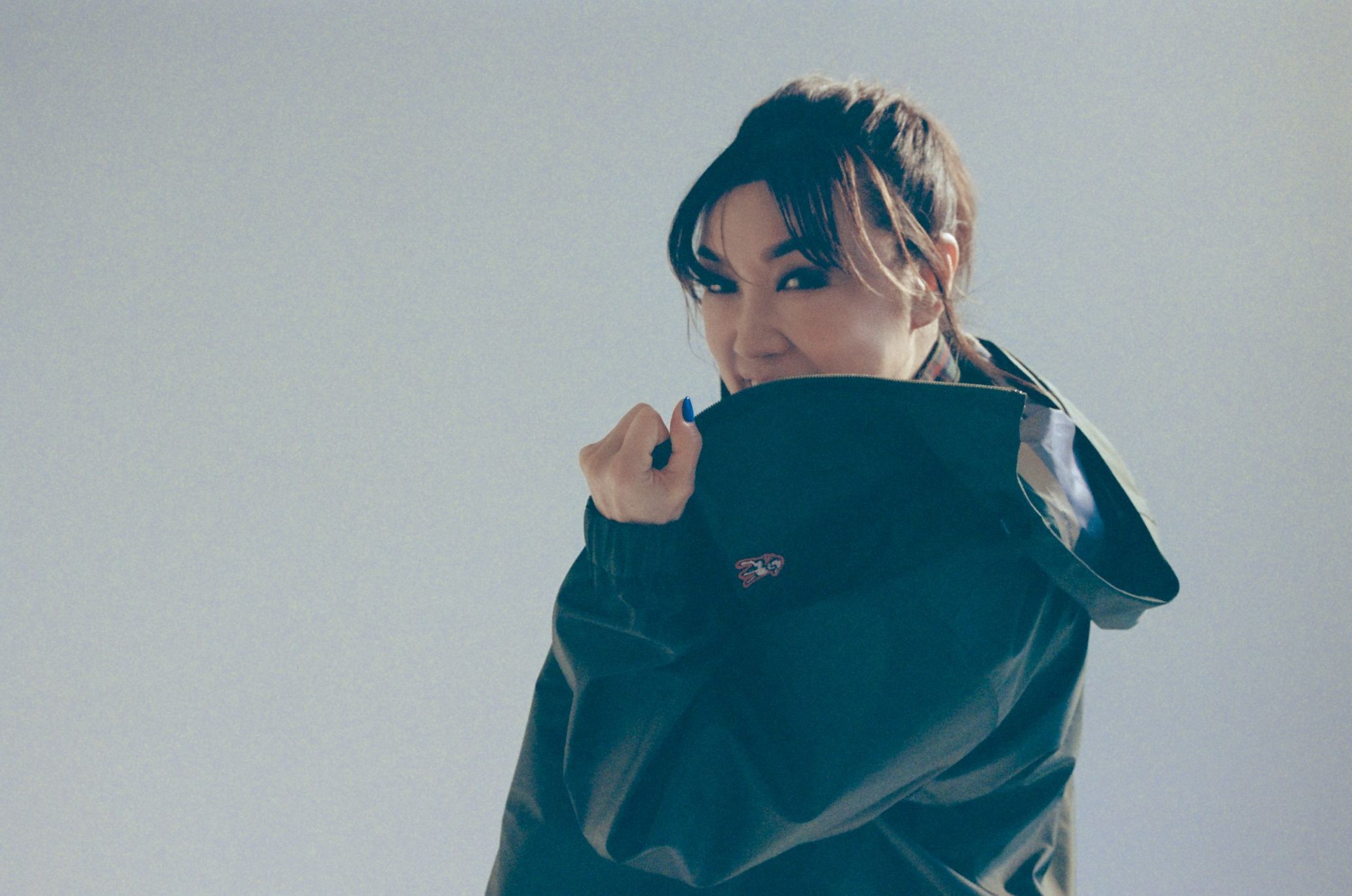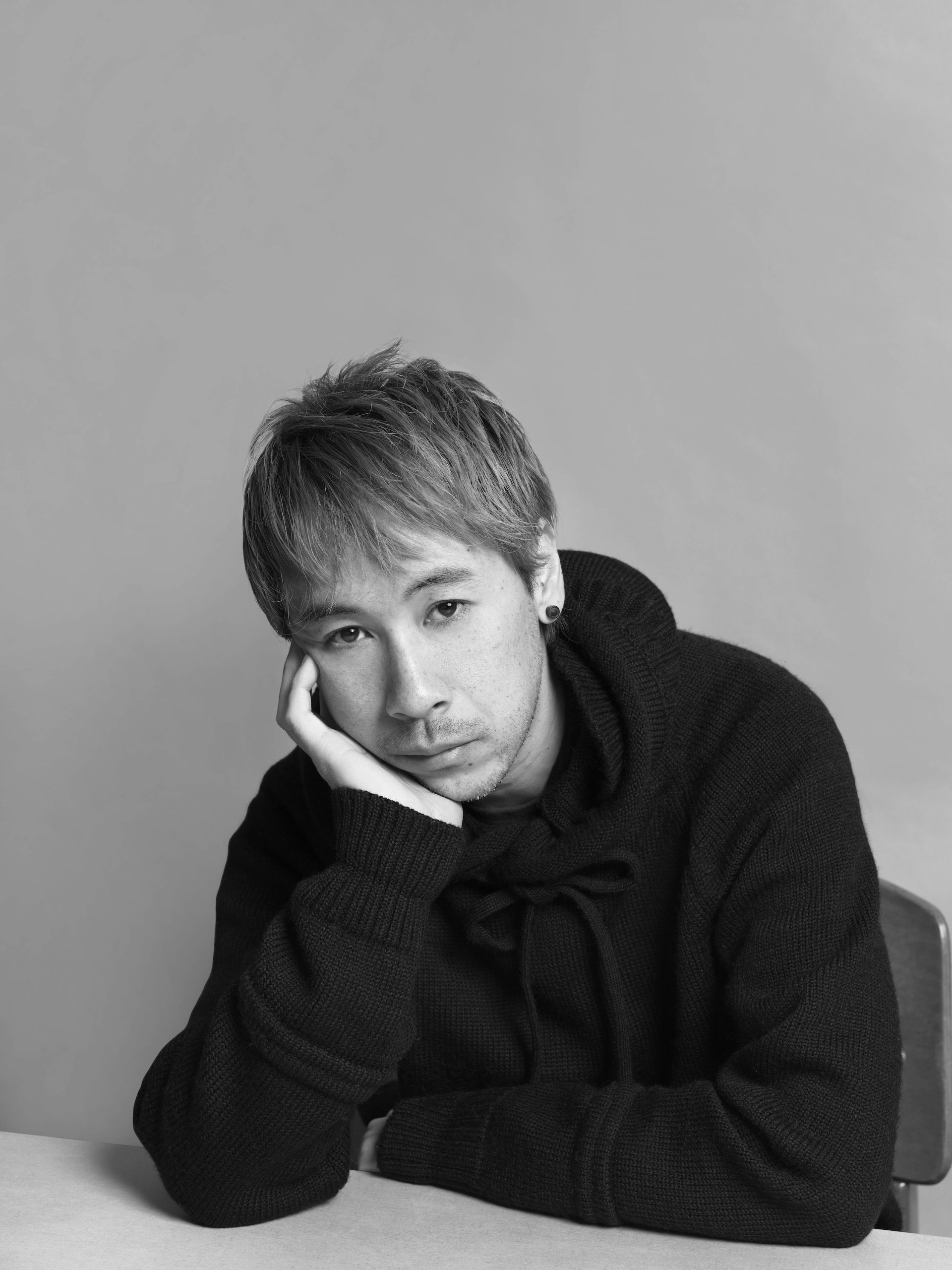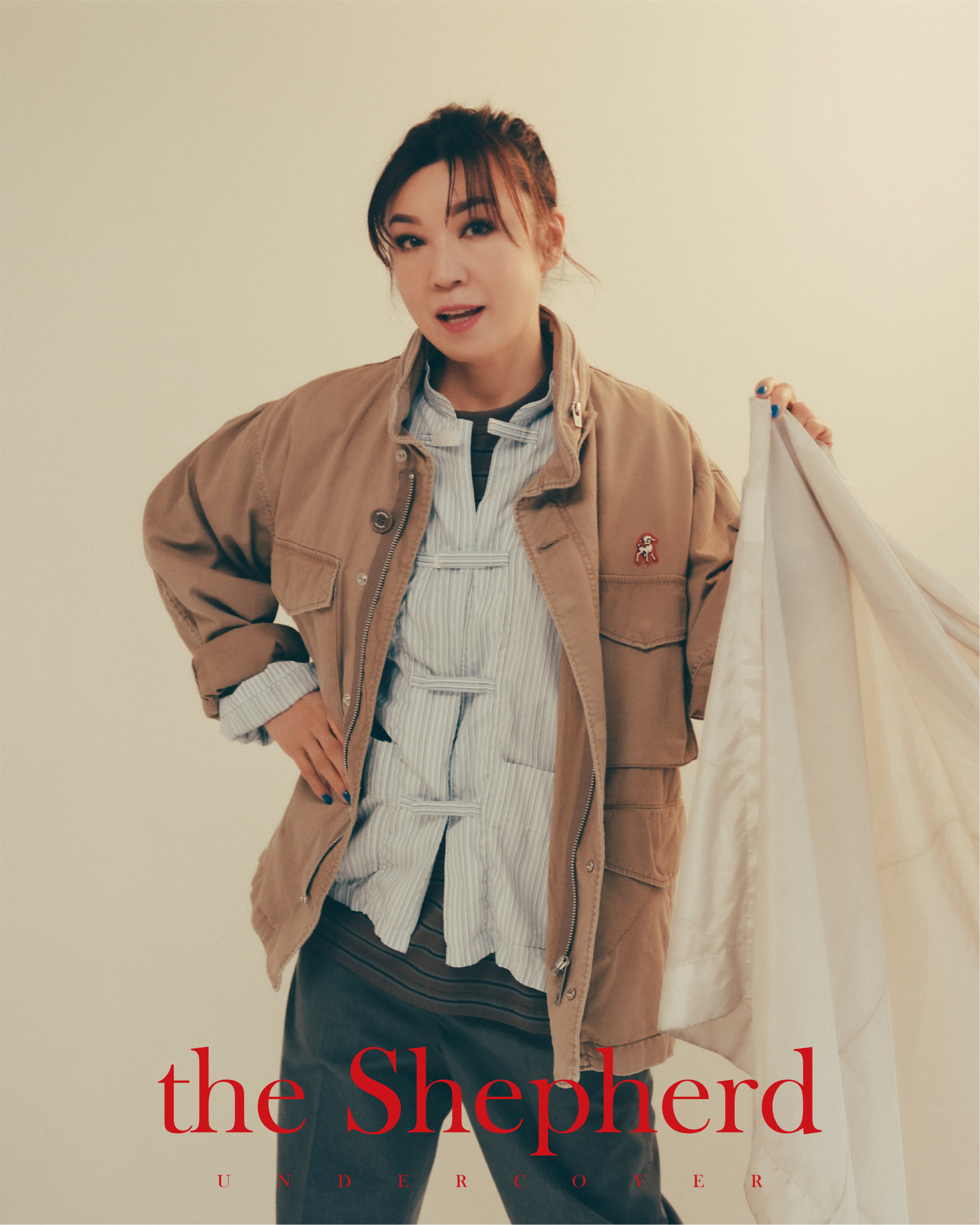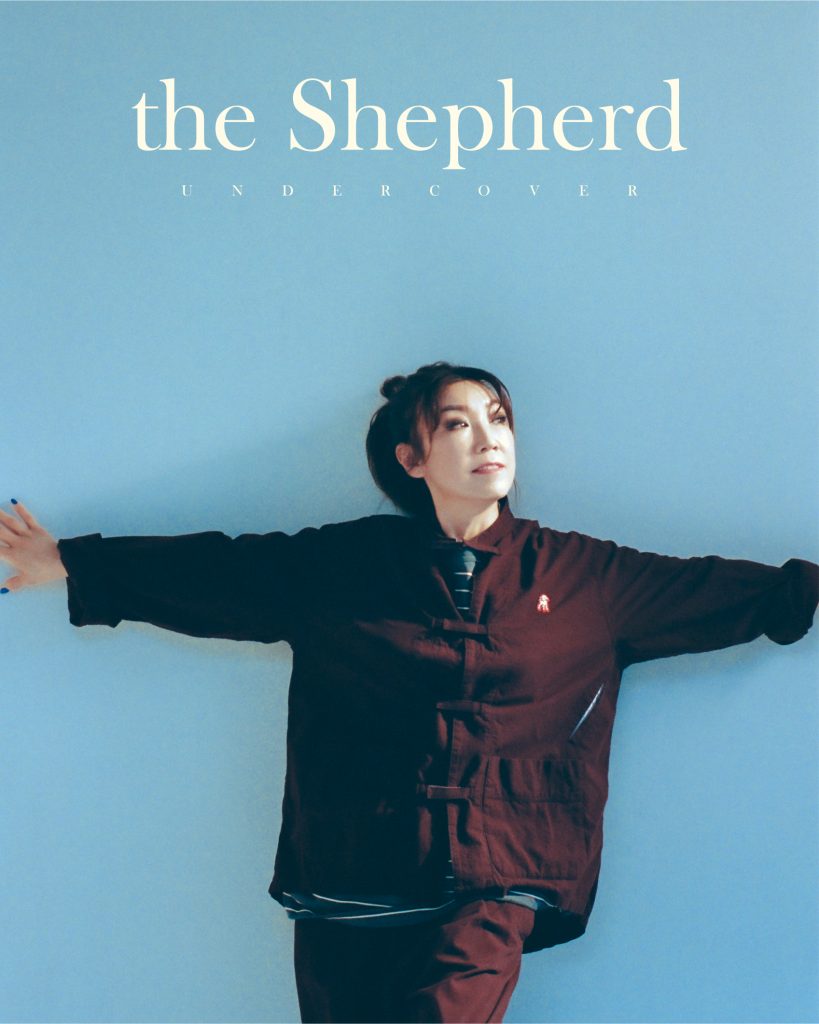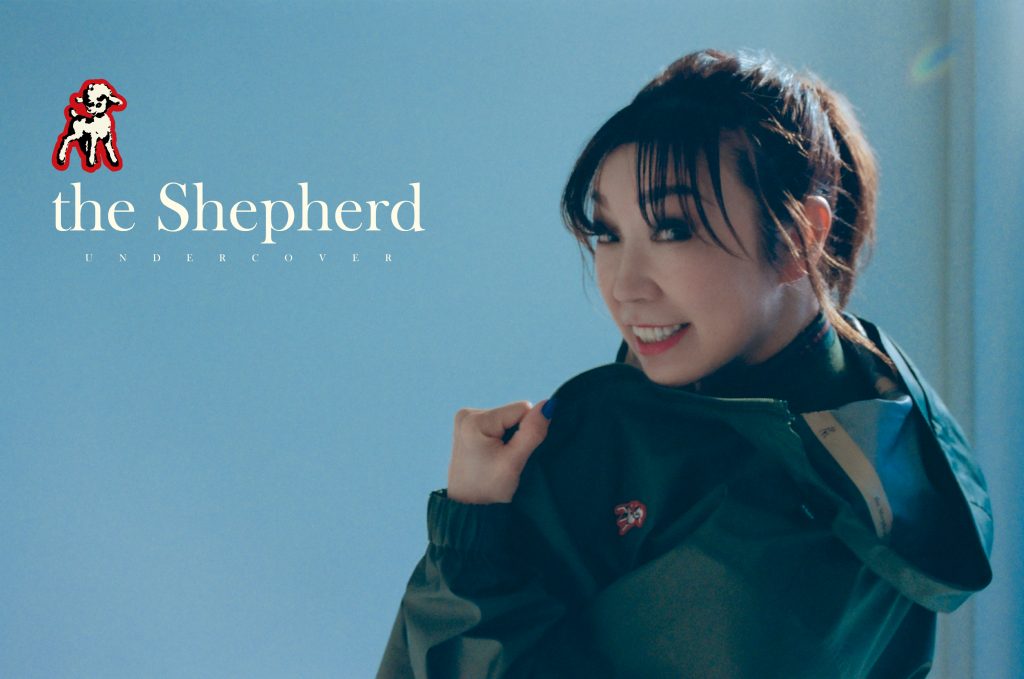Jun Takahashi, the designer of Japanese fashion label “Undercover”, has always tried spectacular experiments in his career. Examples of his wide ranging experiments include not only cutting-edge collections, but also new forms of catwalk shows, development of products in areas outside fashion. Especially for campaign visuals, he has been collaborating with artists from many different backgrounds regardless of how famous they are, instead of depending on a specific culture. This has made him achieve a completely unique status that can never be categorized into a specific genre.
The image visual for The Shepherd Undercover’s Spring / Summer Collection in 2021 features musician Yumi Matsutoya as a model, for which Takahashi himself performed as a stylist. This article, which includes the conversation between the two during the shooting, uncovers the stories about their roots, values for music, and the future.
2.Jun Takahashi Photography Yoshie Tominaga
Music from 1970s as Yumi Matsutoya’s musical roots and the impact of Hipgnosis in 1980s
Yumi Matsutoya: When I first visited London in the late 70’s, I went to the “Seditionaries” shop. When I went there, I came across Vivienne Westwood herself by chance. She was closely guarded by leathermen though.
Jun Takahashi: It’s amazing that you went to the “Seditionaries” store at that time. Did you go to London for sightseeing or a recording?
Matsutoya: It was for sightseeing. I walked all the way from Sloane Square to King’s Road. But that experience later became a source of inspiration for my eighth album, Toki no Nai Hotel.
Takahashi: I see. So, was it around 1978?
Matsutoya: Yes, 1978. It had been about two years since I became Yumi Matsutoya. I myself didn’t go through punk music or fashion, but I felt that I had the same attitude as them. British rock provided a spark for me to try to become a musician in the first place, and I had always had a longing for London. When I was a teenager I was exposed to the so-called British Invasion that had been hailing around the world, so I was obsessed with rock music such as Jimi Hendrix, Eric Clapton and Cream.
Takahashi: It was a great time, wasn’t it?
Matsutoya: It was an era when rock was properly functioning as rock. It was the end of the Vietnam War, or the time when it became fierce. It would also lead to the Wood Stock Festival.
Takahashi: Lately, I often listen to records at home, and I always end up picking up ones from the late 1960s to the 1970s.
Matsutoya: Pink Floyd came out in the 70’s.
Takahashi: Pink Floyd released “Dark Side of the Moon” around that time, right?
Matsutoya: In 1981, I was able to work with Hipgnosis for the first time for “I Will See You Last Night.”
Takahashi: I first listened to the album “I Will See You Last Night” when I was in junior high school. The jacket was really cool. When I was in high school, I got interested in Hipgnosis’s artworks and was amazed by the fact that the jacket had been created by them. How did that happen?
Matsutoya: It was when our company was even smaller than it is now. The student who was forced to become the president of our company offered only one condition, which was to let him do whatever he wanted to do. And one of his wishes was to work with Hipgnosis. That person called Hipgnosis directly and then they really came to us.
Takahashi: I see. That jacket was really cool.
Matsutoya: At that time, Hipgnosis was a company that was run by three people. The group consisted of the creator, Storm Thorgerson, the photographer Peter (Christopherson), and the producer (Aubrey) Powell. I chose one from a number of rough sketches lined up by them in my house at the time. One of what we didn’t choose was later used as a jacket for Pink Floyd’s “A Collection of Great Dance Songs” album.
Takahashi: Oh, was it?
Matsutoya: Also, the other one was used for the jacket of Alan Parsons. By the way, an icon of 90’s culture, the London-based graphic group “Tomato”, to which the electronic group “Underworld” belongs, was also greatly influenced by Hipgnosis. Instead of creating graphics with CG like we do now, everyone was into the analog process. They are geniuses with incredible freehand techniques. That made them even more amazing.
Takahashi: It’s amazing that they were all made in analog fashion. Of course, the sound is amazing, but the jacket is also great. I listened to your “I Will See You Last Night” this morning.
Matsutoya: Glad to hear that! Thank you! There is great value in the fact that we did that in the early 80’s, right? After that, we entered into an age of bubble economy, and I came to be regarded as a quite a materialist or big-spender by the general (laugh). I know there are some people who understand my true self, but I don’t think the majority do so.
Takahashi: But I believe people who have always liked you don’t have that kind of impression.
Encounters with the next generation throughout their decade-long careers
Matsutoya: When do you think Undercover came to the forefront ?
Takahashi: I started it when I was a student, which was in 1990. I did the first show in Tokyo in 1993, which was one of the breakthroughs. And another one was when I started doing shows in Paris in 2000.
Matsutoya: But it’s wonderful because you have been consistent in your actions.
Takahashi: I don’t know if I am (laugh).
Matsutoya: Successful apparel designers tend to stop making things and to buy and sell companies. Do you still want to remain as a creator?
Takahashi: I like making something. It’s not just about clothes, it’s also about drawing. So it’s like, I cannot be satisfied unless I keep making things.
Matsutoya: If you don’t continue, it feels like you get rusty, and you feel uncomfortable, right?
Takahashi: That’s right. By continuing something, I feel that I can create something new and can witness something interesting again.
Matsutoya: If you continue, you will be able to meet important people in the process.
Takahashi: I really think so. I just can’t sell my own label. Well, if I were in desperate trouble… (laugh). But anyway, I’ve been doing it for 30 years now.
Matsutoya: When you were a student, you had a longing for music, fashion or culture of the previous generation. But when you can actually do what you have wanted to, you want to work with the generations who shape the time, or with the talented people of the younger generation.
Takahashi: I agree with it. That is the most interesting because it brings out the different aspects of your own ability. It’s great if both could draw strength from each other.
Matsutoya: Until the other day, there was a retrospective exhibition of Eiko Ishioka (art director). And, people around me asked me: “Did you work with her at the time?” But in reality, there was about 10 years between the time where she was in the forefront and when I started my career. It was when I was a high school student that I was impressed by Parco’s advertisement created by her. But when I started making something myself, I was not interested in collaborating with established creators. But that was not the case with creators from foreign countries.
Takahashi: That may be true. Do you have any projects with young people?
Matsutoya: I have some. I am glad that they want to meet me. The day after tomorrow, I will be meeting with Daiki Tsuneta from the band King Gnu.
Takahashi: I reckon there are a lot of fans in their 20s like him, right?
Matsutoya: Well, it means that their parents were listening to my music. However, it seems that people, especially men, are particularly interested in what it means to continue something for 50 years. We end up talking about the contents though.
Takahashi: Musicians must be really interested in that.
Matsutoya: They tend to ask me: “how can I continue it?” But the only thing I can say is: “Just continue it.” (laugh) If you quit, it will end at that point.
Takahashi: Also, things just continue naturally.
Matsutoya: Yeah, there are also reliable supporters and collaborators.
“People look at the past and move ahead, facing rearwards.”
Takahashi: How many years have you been active so far? 50 years?
Matsutoya: It will be 50 years next year.
Takahashi: That makes me think Undercover is still a child (laugh).
Matsutoya: The more time you continue it, the steeper the slope becomes to the extent which you feel as if you are walking towards the vertex of an inverted parabolic curve. Things go on in quite a pace until about 10 or 20 years, but from there the slope will become steeper.
Takahashi: Yes, it’s going to be steeper.
Matsutoya: It seems it went by so fast in retrospect, but if you try to do it from now on, the goal just seems too far.
Takahashi: Yes, it really does.
Matsutoya: One of the philosophies of Beat Culture says: “People look at the past and move ahead, facing rearward.” It’s easy to see what has been done so far. We can move forward, thinking that since we’ve done this and that so far, we should put my legs out like this.
Takahashi: Certainly, that is true. Making things is like drawing something out from yourself and wringing your own neck with it.
Matsutoya: The standards of creation will also be elevated.
Takahashi: Yes, the standards will be elevated. Also, you will have to draw out a source of an idea from yourself. The result will be that the contents of the drawer will increase, but it becomes more difficult to balance them. However, new things are sometimes born from unexpected places, and that kind of interesting things will make you continue unknowingly.
Matsutoya: Sometimes you will find the drawer you have forgotten. And when you open it, you will say: “Oh, there are quite a few ideas.”
Takahashi: You will also find and say: “I didn’t know that I had something like this.”
Matsutoya: Even what has been done in the past will never be old because you will see it from a different perspective.
Takahashi: The interpretation is also different, and you can fix it yourself.
Matsutoya: It was exactly your generation that embodied those kind of things such as editing and collages, right?
Takahashi: That’s right because the 90’s can be described as a remix generation. But when I was young, foundational quality of myself was formed in the 70’s and 80’s. So, I have experienced the gap between analog and digital. It’s quite interesting to be able to deal with both, now I’m completely into analog though.
Matsutoya: There is a lot of information right now. Looking from a perspective of the generation who thought that there was no information, there is just too much now.
Takahashi: With the analog method, every part of a thing is more easily visible than digital. So, you can look at more detailed and deeper parts of it. That may be why I prefer analog. Even among young people today, the number of musicians who are into analog is increasing.
Matsutoya: That may be true. In my opinion, people will stand at a crossroad in in their 50s. Some people keep an aggressive attitude, and others will be satisfied with the positions they are in.
Takahashi: What kind of people are those who are satisfied with where they are now?
Matsutoya: I can’t give you specific examples, but they are someone who would say: “I don’t mind staying in this position.” But it’s a matter of personal preference.
Takahashi: Are they someone who won’t evolve, but will go slowly?
Matsutoya: You could say that.
Takahashi:I’m turning 52 years old this year, and I haven’t been able to make up my mind. I have no problem with going at this pace, but sometimes I feel like slowing down. I am just wondering if I can balance both attitudes.
Matsutoya: In order to keep quality high, we take more time to work on something. We also have to care about our own body.
Takahashi: I really think so too. In that case, we can no longer deal with the amount of work I’ve been doing. I would like to take more time to maintain the quality one by one. I think that’s how you should spend your time slowly.
The importance of worrying, feeling anxious, and experiencing a plateau as a step to move forward
Matsutoya: From a third-person perspective, I think the 40s is the age where men can try out various kinds of things. They have wider horizons and still have physical strength.
Takahashi: In your 40s, there are 10 years that you can spend on accelerating the things that you developed during your 30s. I think in your 50s, you become more matured to some extent, but it becomes difficult to go further. My life is going through a big change these days. In this situation, part of me wants to relax and another part of me wants to go aggressively, and I haven’t reached a conclusion yet. For me, this change is very interesting, but I’m feeling confused about what I should do.
Matsutoya: Well, when I speak to those people (who are in a similar situation), I tell them “natural lawn and ‘grassy’ lawn are different”, and they understand. Looking natural means well-maintained.
Takahashi: And “grassy” means untrimmed.
Matsutoya: People need to put effort to take care of themselves and relax to do what they want to do. If you go easy on that, you just become an old dude. (laugh) When I meet a guy, I can tell instantly if he belongs to such a group or not.
Takahashi: Sometimes I overthink, but I guess now is the time for change. Did you also have such a moment?
Matsutoya: Well, there may be some differences between men and women, or maybe this is due to the differences between music and fashion scenes, but sometimes I feel glad that I didn’t ease up when I was in my 50s.
Takahashi: There are many things that we don’t realize at the time.
Matsutoya: For example, when you really need to improve a skill, say, for skiing or speaking English, it’s hard to recognize the changes, as if staying on a landing for a long time when climbing up the stairs. You might feel that all your efforts might end up being a waste, but without experiencing such a difficulty, you can’t go further.
Takahashi: That phase, the period of stagnation, is very important. You go through hard times, such as being worried or feeling like giving up, but you need to overcome such difficulties, otherwise, you can’t go ahead.
Matsutoya: You might worry if you’re just being consumed or fear young people excessively, but now I feel those thoughts are no big deal.
Takahashi: When I look at people with a new type of strength, I kind of feel left out. But at the same time, I tend to forget that I have strength that I’ve gained over the years.
Matsutoya: Because, at the time, you forget the times when you had so much power.
Takahashi: Young people today tend to give up so easily, but maybe that’s because they don’t really like what they are doing.
Matsutoya: Maybe it’s because they tend to seek answers immediately.
Takahashi: Or maybe they’re feeling that they must act fast.
Matsutoya: I think it depends on people, but to them, it’s all or nothing. There’s nothing in between.
Takahashi: There are many people who are like that.
Matsutoya: As part of the process of transitioning to the age of International Space Station, or the age of global governance, I’ve heard that humans may be programmed to survive even if they’re only given a small space. (laugh) It seems so rigid when seen from the perspective we used to have, but people are acting very freely within that restriction. Consumers also need to be educated, otherwise, they will be gone. Even if we explain how good the sashimi of wild-caught fish tastes, people who prefer supplements won’t understand.
Takahashi: The world might turn into such a state.
――In that case, the same goes for fashion. Everything is available online, but after all, what we enjoy is the act of shopping at a physical store.
The balance between the cool and the real (everyday life)
Takahashi: (Due to the pandemic) things have become difficult to engage physically today. I grew up thinking there are emotional experiences that you can only have by being there, especially with live music. This may sound bad, but if you think in such a way, I feel musicians are a little unfair. (laugh) I really envy them.
Matsutoya: At the same time, it can be fierce. There’s a lot of artists, and there used to be a lot of fans for one artist, but today, since everyone began to make their own works available to public. Instead of celebrating what people have made, everyone is inclined towards becoming an artist. You can become popular and disappear in no time. Is there such a system that creates “stars” in fashion as well?
Takahashi: You can see that in big fashion houses, like Louis Vuitton. They keep changing their designers. They used to choose new designers by ability, but now, they tend to select people with outstanding character, which I’m not convinced of.
Matsutoya: Like Virgil Abloh?
Takahashi: They were influenced by what we’ve done in Harajuku in the 90s, so it makes me feel very complicated sometimes.
Matsutoya: Such struggles are parts of your 50s. You’re inclined to feel you are being consumed. The things you’ve been doing appears in front of you very easily. But they just come and go in turns.
Takahashi: Perhaps, I’ll be able to access the next stage when I overcome that struggle.
Matsutoya: Taking away those fences. Probably that’s the only way.
Takahashi: That’s true after all. My interest won’t fade away after all these years, so I suppose there will be changes if I continue working on it. With all my experiences, even if I do the same thing as young people, the outcome would be something different.
Matsutoya: You can make them more hybrid, for instance.
Takahashi: There’s a lot I can do. What matters is how much I can enjoy it.
Matsutoya: For example, providing a fresh perspective is one way. I guess that’s the point in design. With different elements such as philosophy combined, it makes people realize a new perspective.
Takahashi: You mean approaches. In fashion, designers like Margiela, when he was designing his own label , made us aware that there are different ways to think about and look at fashion. The same is true when starting a new genre in music. That’s such an amazing thing to do.
Matsutoya: It won’t be interesting if you don’t balance the cool with the real in clothing. Even if “cool” modern music win praise, the concept of “cool” may change tomorrow. How you can blend that music into the lives of people, integrating to the point they can sing to themselves, is what matters. That’s why it’s great.
Takahashi: The point is, how much you can make it blend into everyday lives. Making it radical or cool is another thing. Achieving the balance is the crucial part.
Matsutoya: Yes, I agree. Well, it was fun to speak with you today. Thank you so much.
Takahashi: Thank you too!
Yumi Matsutoya
Born in 1954 in Tokyo, Japan. A female singer-songwriter from Tokyo, she made her professional debut as a composer in 1971, and made her debut as a singer in 1972 as Yumi Arai, becoming a pioneer among female singers and songwriters. In 2020, she released her first original album in four years, “Shinkai No Machi”, and will be touring with this album from September 2021 for a total of 60 concerts under the title “Yumi Matsutoya Concert Tour: Shinkai No Machi”.
Jun Takahashi
Born in Kiryu City, Gunma, Japan. Graduated from Bunka Fashion College in 1991. Founded his own fashion brand “UNDERCOVER” while he was in college.In 1994, UNDERCOVER’s inaugural collection 1994-95 Autumn/Winter launched in Tokyo. In 2002, made a first appearance at Women’s Fashion Week 2003 Spring/Summer in Paris. Since then, the brand has been participating at fashion shows mainly in Paris. He founded a creative team “UNDERCOVER PRODUCTION” in 2018.
Photography Shunya Arai
Interview & Text Hiroshi Kagiyama
Translation Shinichiro Sato

